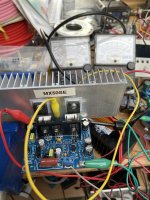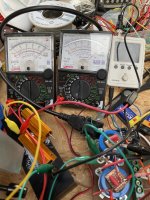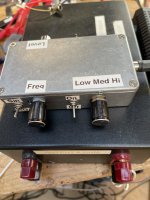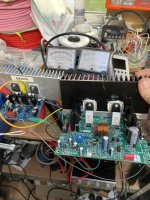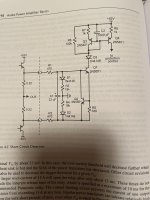So as mentioned a few days ago I dug out my MX 50SE and took some measurements.
I used my Rod Elliot miniosc to provide a signal. I turned up the level until both meters in series with the power rails (sorry Mooly! 🙂) were reading 250ma. As expected there was 10ma difference between the rails. At turn on the current was about 50ma per rail that crept up to 70ma at which point it was stable. After applying the input signal with my 100W 8ohm resistor on the output the output voltage was around 5V. This is about 3W RMS.
The ambient temperature in my shed was 19C. You can see on the yellow meter with the thermocouple on the heatsink that the heatsink temp was around 44 degrees in the middle of the heatsink. After about 30 minutes that is where the temperature stabilized. There was negligible variation as I changed the frequency from about 150Hz to 15KHz.
The outer edges of the heatsink were much cooler as the substrate on those thin heatsinks isn’t thick enough to carry the heat evenly over the whole area.
I include a picture with my Douglas Self Blameless amp that has the same power as the mx50, but I attached the upgraded heatsink to that one and the heat spreads much more evenly on that one.
There is no problem with heat at this low power, even though I’m using the small heatsink so if yours does there is still a problem somewhere.
Do note that my heatsink was clamped in a bench vice (or vise for US readers!) so had great airflow all around.
My load resistor is on a big heatsink so didn’t change temperature as measured with my finger 😀.
I’m using 25-0-25 Trafo that gives me +-35V at low load. This gives about 50W at clipping.
I used my Rod Elliot miniosc to provide a signal. I turned up the level until both meters in series with the power rails (sorry Mooly! 🙂) were reading 250ma. As expected there was 10ma difference between the rails. At turn on the current was about 50ma per rail that crept up to 70ma at which point it was stable. After applying the input signal with my 100W 8ohm resistor on the output the output voltage was around 5V. This is about 3W RMS.
The ambient temperature in my shed was 19C. You can see on the yellow meter with the thermocouple on the heatsink that the heatsink temp was around 44 degrees in the middle of the heatsink. After about 30 minutes that is where the temperature stabilized. There was negligible variation as I changed the frequency from about 150Hz to 15KHz.
The outer edges of the heatsink were much cooler as the substrate on those thin heatsinks isn’t thick enough to carry the heat evenly over the whole area.
I include a picture with my Douglas Self Blameless amp that has the same power as the mx50, but I attached the upgraded heatsink to that one and the heat spreads much more evenly on that one.
There is no problem with heat at this low power, even though I’m using the small heatsink so if yours does there is still a problem somewhere.
Do note that my heatsink was clamped in a bench vice (or vise for US readers!) so had great airflow all around.
My load resistor is on a big heatsink so didn’t change temperature as measured with my finger 😀.
I’m using 25-0-25 Trafo that gives me +-35V at low load. This gives about 50W at clipping.
Attachments
Hehe 🙂I turned up the level until both meters in series with the power rails (sorry Mooly!
All your results sound pretty normal as expected really.
I’m using 25-0-25 Trafo that gives me +-35V at low load. This gives about 50W at clipping.
Smaller (less rail voltage) is often preferable unless you can demonstrably prove you need that extra power and the lower voltage has a big impact on dissipation.
👍
44c or 111F is kinda hot it’s enough where you can’t hold you hand on it for more then a few sec right ? I have no way of measuring temps so I go by feel mine I can hold my hand on the heatsink for about 7 sec before it starts hurting and that is at 1.5w so I don’t know if I should further investigate it or I’m running normal ?
44C is just above body temperature (37C) so on mine you can hold on to the heatsink as long as you like. In Fahrenheit I think body temp is 98 so 111 is not much hotter. From your comments I think yours must be about 60 as you couldn’t hold on to that for very long.
As you can see on the little scope trace I was using a sine wave. If you were using music then that introduces uncertainty.
As you can see on the little scope trace I was using a sine wave. If you were using music then that introduces uncertainty.
Hey guys should I put a coil on the output or resistor to stop the amp from exploding if the outputs gets shorted by accident
A coil won’t help with that. A 4 ohm resistor would, but that will get hot, reduce output power and will significantly change the response of your speakers so in practice this isn’t done. Short circuit protection needs to be designed in to the amp. It is not always easy to retro fit. A smaller resistor almost certainly would not protect this amplifier.
Dam I’m going to install a speaker protection circuit that blocks dc but I don’t think it does short curious protection
The problem is that short circuit protection would have to be quick cause as soon as a short happens this amp blows it’s very quick
Yep. Transistors blow way faster than fuses, even quick blow ones. The fuses just stop the power supply from going on fire.
I found a circuit in Bob Cordell’s book that might do the trick but you’d need to figure out how to drive the relay from this, this is part of a very comprehensive set of protection circuits.
I found a circuit in Bob Cordell’s book that might do the trick but you’d need to figure out how to drive the relay from this, this is part of a very comprehensive set of protection circuits.
Attachments
Would a relay even be fast enough to cut power before the transistor goes up I’m flames? What a nightmare this build has been lol but I’ve learned a lot so I can’t really be angry about it but it is like everything I solve there is another problem. But so far I’ve solved everyone of them but this one might be a bit tricky
There must be another way to come up with a solution ! How do manufacturers do it I don’t see an amp protection circuit I’m my amplifier but again I’ve never shorted out the outputs so who knows !
A suitable coil helps with stability while a coil plus resistor (even a low value like 0.22 ohm) also helps if the amp is shorted with no signal. The small resistance allows the feedback to maintain correct DC conditions.Hey guys should I put a coil on the output or resistor to stop the amp from exploding if the outputs gets shorted by accident
We covered all this earlier 🙂
I hate that the only way to test to see if that actually works is by shorting it out lol hopefully it works
Ohh do you guys mean replacing the 0.1ohm with 0.22? I thought I could just solder and extra 0.1 to the output and that would solve it would that work ?
- Home
- Amplifiers
- Solid State
- MX50SE problem please help
